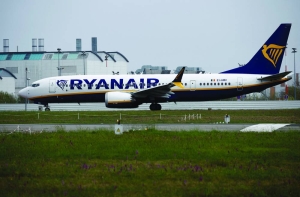GM beats quarterly expectations and raises forecast

The company’s shares plunged more than 6%, however.
The selloff could be related to a number of factors, analysts said, including a shift in the company’s Cruise self-driving vehicle strategy, its continued losses in China and a broader concern that the auto industry will become less disciplined on inventory levels and buyer incentives.
“We believe this is just a knee-jerk reaction and the GM quarter was a robust one which should drive the stock higher over the coming weeks and months,” said Dan Ives, analyst at Wedbush Securities.
The Michigan automaker is leaning heavily on its gasoline-engine offerings to fuel its profits through a slower-than-anticipated transition to electric vehicles.
GM executives say the company has laid the foundation necessary to meet ambitious ramp-up targets on EVs.
“We’re encouraged by the early results we’re seeing in EVs now that we can build at scale,” CFO Paul Jacobson said in a call with reporters.
A report from the Federal Reserve last week showed motor-vehicle production surged to a nine-year high in June.
GM increased its adjusted pre-tax profit projection for the year to $13bn to $15bn, from its previous range of $12.5bn to $14.5bn.
The company reported adjusted earnings per share of $3.06 that beat Wall Street’s average estimate of $2.75, according to LSEG data. The carmaker reported $48bn in revenue for the three-month period, surpassing analysts’ consensus of $45.5bn in the June quarter. Executives at GM also provided an update on its Cruise self-driving unit, saying it will focus its development efforts on a next-generation Chevrolet Bolt rather than its planned futuristic Origin vehicle that would not have a steering wheel or other human controls.
GM’s stock has outperformed its rivals and the S&P 500 in 2024. The company’s share price has increased 38% this year as of Monday, while cross-town rival Ford Motor has notched an 18% increase, and Jeep-maker Stellantis lost 11%.
GM received another cash boost from the US government this summer to support its EV ambitions, although it has walked back many of its targets during the last year. The Biden administration said this month that it would award GM $500mn to convert one of its Michigan gas-engine vehicle-assembly plants to produce EVs. GM last week declined to reiterate a target of achieving 1mn units of EV production capacity in North America by the end of 2025. The carmaker also recently lowered its projected EV output for the year, now projecting the higher end of its 2024 production to be 250,000 units, down from a prior forecast of 300,000 units.
CEO Mary Barra told investors that GM would delay the opening of its Orion Assembly EV truck plant by six months, until mid-2026.
Still, GM executives said the company is scaling up production of the Chevrolet Equinox EV and plans to launch several new battery-powered models over the coming months.
GM reported a 14% increase in net income over the year-ago period to $2.9bn. Although the Detroit automaker has kept its sights set on transitioning its lineup to EVs, Barra has said it plans to introduce plug-in hybrids in 2027. Ford is currently benefiting from significant increases in hybrid sales.
Ford is set to release its second-quarter results Wednesday.
The outcome of the US presidential election in November will also likely affect GM’s plans for battery-powered vehicles. Former President Donald Trump has criticized President Joe Biden’s approach on EVs, which have included significant government subsidies.
GM is also facing increasing investor scrutiny on its operations in China, which in the past decade have shifted from being a profit engine to a drain on the company’s finances.
The company recorded a $104mn quarterly loss in China, a disappointment after executives said they expected to be profitable in the region for the second quarter. “It’s a difficult market right now. And frankly, it’s unsustainable, because the amount of companies losing money there cannot continue indefinitely,” Barra said.
Jacobson said GM would work with its joint-venture partner in China to restructure its business and plans to cut spending there.
Spotify
Spotify posted a record quarterly profit slightly ahead of analyst expectations on Tuesday, pushing its shares up more than 14% in premarket trading.
The Swedish audio-streaming giant sought to reduce costs through layoffs and cuts to its marketing budget last year, while trying to grow its user base through promotions and new investments in podcasts.
In the second quarter of 2024, the number of paying Spotify subscribers rose to 246mn, slightly above expectations.
“It really comes down to the number of subscription offerings we have now. We’re moving from one-size-fits-all to having something for everyone,” CEO Daniel Ek said in an interview with Reuters, citing the company’s various plans for students and shared households.
Profit rose 45% from a year earlier to €1.11bn ($1.21bn), slightly above analysts’ expectations for €1.07bn. Earnings per share of €1.33 also beat estimates of €1.06, according to IBES data from LSEG. Revenue rose 20% to €3.81bn for the second quarter of 2024, fractionally below analysts’ estimates of €3.82bn. The company did fall short of its own target for monthly active users (MAUs). Spotify previously said it aimed to reach 631mn monthly active users (MAUs), but only reached 626mn for the quarter.
“In a nutshell, it was a very good quarter for them,” said Simon Dyson, an analyst at Omdia, a consultancy firm which focuses on media, telecoms and communications.
“They did miss their MAU, but within their guidance they are still confident that number will go up, and if they stay on track we’ll all forget about them missing it this quarter.”
The company said it had seen user numbers grow across all regions, but that it had not met its MAU goal due to “continued recalibration” of marketing activities.
“It’s definitely something we take very seriously, if we miss our own forecasts,” said Ek. “For me, it’s a question of when, not if. We will return to strong MAU growth, I feel good about it.” Spotify’s gross profit margin widened to 29.2% from 27.6% in the previous quarter.
Galp Energia
Portugal’s Galp Energia reported on Monday a 16% rise in second-quarter net profit, beating expectations as higher oil prices and lower production costs offset reduced output and the refining margin held steady.
The company also confirmed ongoing preparations for a second drilling phase of four wells in Namibia’s Mopane field, where it has an 80% stake, starting in the fourth quarter. It said it was in preliminary talks with possible partners.
Galp shares, up more than 40% so far this year, rose more than 1%.
It booked an adjusted net profit of €299mn ($325.34mn), above the €236mn expected by 18 analysts polled by the company.
Adjusted earnings before interest, taxes, depreciation and amortisation (EBITDA) fell 7% to €849mn, compared with the €821mn consensus.
Galp has estimated Mopane could contain at least 10bn barrels of oil, making it one of the largest discoveries in the nascent basin following successful exploration by TotalEnergies and Shell.
Reuters reported earlier that more than 12 oil companies, including Exxon, Shell and Brazil’s Petrobras, had expressed interest in buying a 40% stake in Mopane.
Ryanair
Ryanair’s profits slumped by almost half in the three months to the end of June as ticket prices plunged 15% from the same period last year, heightening fears of a weak summer for Europe’s airlines as the post-Covid boom peters out.
“The trend is downwards and weaker,” Ryanair Chief Executive Michael O’Leary told investors in an analyst call after the results on Monday.
After-tax profit for the three months to the end of June, the first quarter of Ryanair’s financial year, was €360mn ($392mn), down 46% on the same period last year and well below the €538mn profit forecast in a company poll of analysts.
O’Leary said it was far too early to forecast the outlook for the year, but said there was no sign of an end to the weakness.
“It could well be a double-digit (percentage) decline in pricing in Q2,” he said, referring to the July-September quarter. “And at that stage… all bets are off in Q3 and Q4.” O’Leary, who in May had forecast fares “flat to modestly up” for the summer, said the best case for July-September was now falls of 5%.
Ryanair makes significant profit from high last-minute fares, but O’Leary said every time in recent weeks that it removed lower-priced fares for last-minute tickets, the remaining higher-priced tickets failed to sell.
“We are repeatedly seeing price resistance,” he said, adding that the airline planned to “aggressively” advertise low fares.
Chief Financial Officer Neil Sorahan put the weakness down to consumers being “a little bit more frugal, a bit more cautious” and a “rebalancing” after two years of double-digit growth in fares.
Asked when the weakness might end, Sorahan said: “Who knows?”
Liberum analyst Gerald Khoo said he expected significant downside risk to consensus estimates for Ryanair’s full-year profit as a result of the results.
“More aggressive pricing by the market leader is likely to result in adverse fallout for the other European airlines,” Khoo said in a note.
O’Leary said Boeing had warned him in recent days that some 737 MAX deliveries due by next spring would be delayed until the peak summer months of 2025 — a repeat of delays this year that forced a cut in summer traffic volumes.
“We will have less capacity into summer ’25 than we were originally scheduled to have,” he said.







